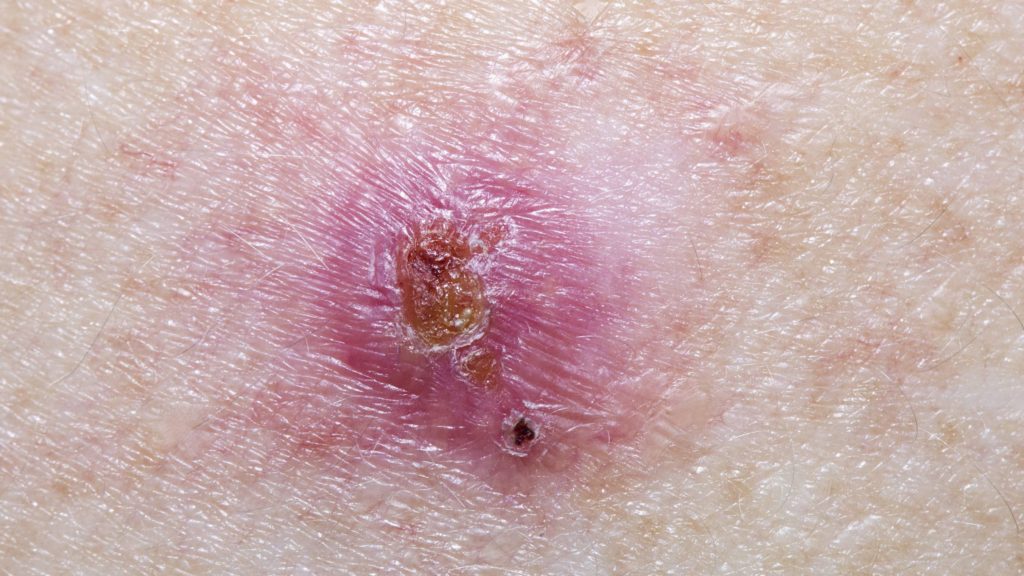-
Solid organ transplant patients are at higher risk of skin cancer and require coordinated care, Mayo Clinic researchers find

More than half of all patients who receive solid organ transplants will have an incidence of skin cancer at some point — most often a nonmelanoma cancer, such as basal cell carcinoma or squamous cell carcinoma. This increased risk can be several hundred times higher than in the general population.
The increased risk is related to long-term immunosuppressive therapy required for transplanted organ survival, which affects the immune system's ability to monitor cells for abnormalities. With a growing and aging population of solid organ transplant recipients, it's essential that patients are well-informed and monitored by a multidisciplinary health care team that includes dermatologists, according to Leila Tolaymat, M.D., a dermatologist and residency program director for Mayo Clinic in Florida.
"Skin cancer prevention and treatment are a cornerstone of long-term survival after organ transplantation," says Dr. Tolaymat. "It's important that all members of the patient's health care team are aware of the unique risks for transplant recipients and are familiar with prevention and treatment protocols."
Dr. Tolaymat is the senior author of a comprehensive overview on skin cancer and solid organ transplant recipients, published in Mayo Clinic Proceedings. The article reviews recent medical literature and outlines findings for clinicians who care for transplant recipients but are not dermatologists.
"While dermatologists are involved in treating carcinomas and other neoplasms in high-risk patients, an understanding of skin cancer risk, development and management is important across all members of the patient care team," she says.
Nonmelanoma skin cancers, such as basal cell carcinoma or squamous cell carcinomas, are the most common types of skin cancer that organ transplant recipients tend to develop. Melanoma, although less common than nonmelanoma skin cancer, is more frequent among organ transplant recipients compared to the general population.
Cutaneous squamous cell carcinoma is the most common malignant neoplasm seen in these transplant recipients, who are at risk for worse outcomes, including a skin cancer-specific mortality rate that is 9 times higher than the general population, according to the article. Basal cell carcinoma is the second most common type of skin cancer among transplant patients. Fortunately, it has much lower potential for metastasis and death. The most common treatment approaches are excision and other surgical techniques.
Organ transplant recipients have an increased risk of melanoma estimated at up to 5 times the risk for the general population, with an especially increased risk for Black patients. Findings also suggest that melanoma has a more aggressive disease course among transplant recipients.
"Prevention is the cornerstone of skin health in transplant recipients," says Dr. Tolaymat. This involves education, taking appropriate measures, such as avoiding prolonged exposure to sunlight and using sunscreen, and having regular skin cancer screenings. A dermatology referral often is made at the time of organ transplant, but education and screening should begin before a potential transplant. Any preexisting skin cancer or precancers should be promptly treated before transplant.
Reduction in immunosuppressive medications can be effective for skin cancer prevention and treatment, though the risks and potential benefits must be discussed with the patient's full multidisciplinary team and requires close monitoring. Therapies such as immune checkpoint inhibitors are possible options when more traditional approaches are not feasible, though checkpoint inhibitor therapy comes with the risk of allograft rejection.
"Regular screening and photoprotective measures are critical in organ transplant recipients, but additional approaches can be used to reduce the risk of skin cancer development," says Dr. Tolaymat.
Media contact:
- Jay Furst, Mayo Clinic Education Communications, newsbureau@mayo.edu
###







